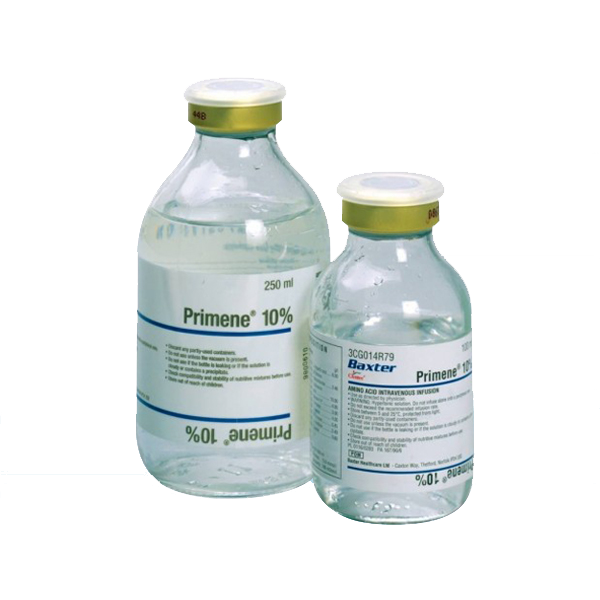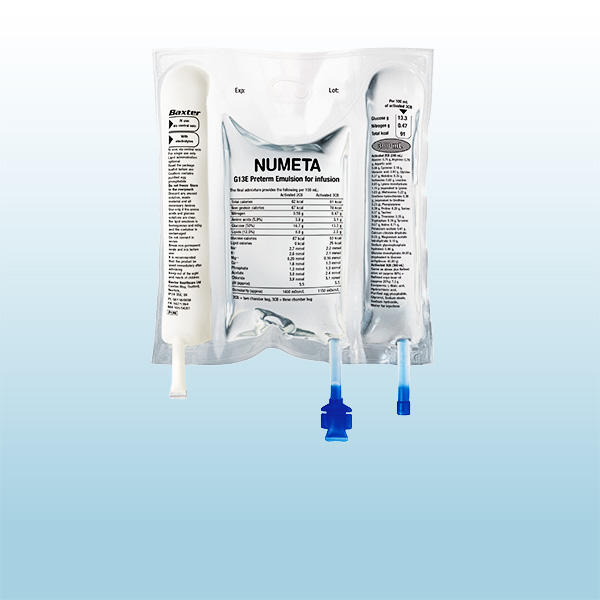Amino Acids
Baxter offers a portfolio of intravenous amino acid solutions specifically tailored to support growth in newborns and children and to meet the protein needs of adult patients.

Protein is critical not only for enabling growth and development in neonatal and pediatric patients,1 but also for maintaining lean body mass and supporting recovery in adults.2 When oral or enteral protein intake is not possible, insufficient, or contraindicated, parenteral amino acid solutions can be used.2,13 Primene, Baxter’s 10% amino acid solution for neonatal and pediatric patients, contains a mixture of 20 essential, semi-essential, and non-essential amino acids and is designed to mimic cord plasma levels of preterm and fullterm infants.3,4
See full prescribing information for Primene
See full prescribing information for Synthamin 9, 5.5%
See full prescribing information for Synthamin 14, 8.5%
See full prescribing information for Synthamin 17, 10.0%

Primene 10% for neonatal and pediatric patients
Primene, a 20 amino acid solution, contains the highest cysteine, lysine, and ornithine content per gram of protein of all pediatric amino acid solutions and has been shown to promote growth in height and weight as well as psychomotor development in pediatric pateints.4,15-17,22 Provision of cysteine is necessary for production of glutathione, which is important in antioxidant defense and calcium homeostasis.11, 21 Primene has been meeting pediatric amino acids needs for over 35 years and is the same amino acid solution found in the Numeta portfolio of ready-to-use neonatal and pediatric three-chamber-bags.4,18,23,24

Amino Acids
Download the Baxter Parenteral Nutrition Compatibility Guide for compounding compatibility and stability information.
Learn more about Clinical Nutrition

Related Products
Important safety information
This abbreviated summary of product characteristics (SPC) is intended for international use. Please note that it may differ from the licensed SPC in the country where you are practicing.
Therefore, please always consult your country-specific SPC or package leaflet.
NAME OF THE MEDICINAL PRODUCT
PRIMENE 10%
QUALITATIVE AND QUANTITATIVE COMPOSITION
Each litre of the infusion solution contains:
L-Isoleucine 6.70g ; L-Leucine 10.00g ; L-Valine 7.60g ; L-Lysine 11.00g ; L-Methionine 2.40g ; L-Phenylalanine 4.20g ; L-Threonine 3.70g ; L-Tryptophan 2.00g ; L-Arginine 8.40g ; L-Histidine 3.80g ; L-Alanine 8.00g ; L-Aspartic Acid 6.00g ; L-Cysteine 1.89g; L-Glutamic Acid 10.00g ; Glycine 4.00g ; L-Proline 3.00g ; L-Serine 4.00g ;L-Tyrosine 0.45g ; L-Ornithine Hydrochloride 3.18g ; Taurine 0.60g
In a formulation also containing L-Malic acid, as described in the application.
CLINICAL PARTICULARS
Therapeutic Indications
Primene 10% is indicated in 1) children and infants 2) neonates, at term or premature, of normal or low birth weight when oral or enteral nutrition is impossible, insufficient or contraindicated.
Posology and Method of Administration
Dosage depends on the age, weight and protein catabolism of the child:
The usual range is: 15 – 35 ml of Primene 10%/kg/24 hours
The infusion rate should not exceed 0.05 ml/kg/min.
Recommended flow rates: Neonates and Infants: continuous infusion (over 24 hours).
Children: continuous infusion (over 24 hours) or cyclic infusion (over about 12 hours in 24).
The flow rate should be adjusted according to the dosage, the characteristics of the infusion solution, the total volume intake per 24 hours and the infusion duration.
Route of administration: Primene 10% alone should be administered in a central vein.
Primene 10% in co-administration or as a mixture should be administered according to the final osmolarity of the solution infused, in a peripheral or central vein.
Mode of administration: Primene 10% is usually administered with a source of energy appropriate for the needs of the child, either by co-administration or as a mixture.
Primene 10% may be included in the composition of nutritive mixtures combining carbohydrates, lipids, electrolytes, trace elements and vitamins when compatibility and stability are known.
Contraindications
Use in children with a congenital abnormality in the metabolism of one or more amino-acids.
Special Warnings and Special Precautions for Use
Primene 10% must be used with caution where severe restriction of water intake is necessary, e.g. cardiac, respiratory or renal failure. In cases of renal insufficiency, the nitrogen intake must be adjusted according to the Childs renal clearance. Caution should be exercised in cases of hepatic insufficiency with careful monitoring of blood ammonia levels. Careful monitoring of the infusion and of the clinical and biochemical conditions of the child is essential. In view of its osmolality, Primene 10% should not be infused alone into a superficial vein.
For a detailed posology, Special warnings and precautions, incompatibilities, interactions, pharmacological properties and pharmaceutical particulars, please refer to the full SPC. Medicinal products are subject to medical prescription
Jan 2020

